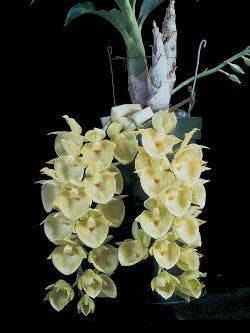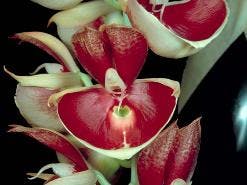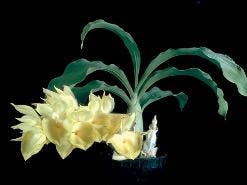Pronunciation: Kat-ah-SEE-tum pee-lee-AH-tum (or pih-lee-AY-tum)

Ctsm. pileatum 'Riopelle', CCM/AOS Grower: James Riopelle Portland, OR
This spectacular Catasetum is widespread from the island of Trinidad, throughout the basins of the Negro and Orinoco Rivers in Brazil and Venezuela and into Colombia and Ecuador. The first plants introduced into England were collected in Venezuela and introduced into cultivation by Linden. The species was described by H. G. Reichenbach in 1882 in the Gardeners' Chronicle. Until 1921 this species was Venezuela's national flower. The Latin name refers to the adjective pileatus or "with a cap", in apparent reference to the hood over the broad lip formed by the carriage of the dorsal sepal and petals.
Catasetum pileatum is an impressive plant even out of flower. The fusiform (spindle-shaped) pseudobulbs grow about 16cm (about 6 inches) tall and the large leaves can reach 40cm (about 16 inches long) making typical plants nearly 60cm (2 feet) tall. Robust clones can be even bigger. Catasetums normally produce flowers of a single sex. The plants themselves are not constrained to one sex or the other as are some plants but any given inflorescence will usually carry flowers that are either male or female with male flowers more prevalent. Male inflorescences can reach 30cm (12 inches) long and carry up to 12 flowers reaching about 13cm (about 5 inches) across. Female inflorescences are typically shorter, fewer-flowered and the fleshy flowers are fewer in number. In some species in the Catasetum Alliance, the differences between male and female flowers are so striking that early taxonomists mistook female forms for different species. Inflorescences in this species are produced from near the base of the maturing pseudobulb typically in late summer or fall although plants are capable of flowering about any time. Mature pseudobulbs on well-grown plants may produce several inflorescences at once or spread out over a fairly long period of time.

Ctsm. pileatum 'Imperial', AM/AOS Grower: Martin J. Nathan, MD Los Angeles, CA
Male Catasetum flowers have a specialized trigger mechanism clearly visible in the center of this flower. Catasetums belong to a group of orchids pollinated by male Euglossine bees (sometimes called "orchid bees"). These bees are attracted to the powerful fragrances produced by these flowers and will swarm in large numbers. When a visiting bee accidentally trips the trigger, the pollinia are forcefully ejected from the anther cap and adhere to the bee's body. The tension in these triggers is substantial and pollinia can be thrown several inches (reportedly up to 6 feet if no obstacles are encountered) from the plant and at a speed measured in excess of 10 ft/second. The force involved in the impact appears to serve two purposes; first to cause the sticky pad to adhere firmly to the insect and second to get the insect to go to another flower.

Ctsm. pileatum 'Kay Rinaman', CBM/AOS A rare yellow form Grower: James Riopelle Portland, OR
Catasetum pileatum is a lowland species where it occurs as an epiphyte. The species is adapted to hot, humid rainforest with only a short dry winter season and this is one species that may not go completely dormant for any period of time. Temperatures range from a maximum of 30C (86F) to a minimum of 15C (59F) and humidity is high at night even in the dry season. While actively growing, plants should be given as much water, warmth and humidity they will tolerate without damage to the foliage and ample fertilizer. These plants are heavy feeders and the goal is to produce the largest pseudobulbs as possible by the onset of late summer. After flowering and when leaves fall, the plants should be kept dry with high humidity and warm temperatures until the newly developing growths have roots about an inch long. With Ctsm. pileatum, this time interval can be quite short and successful growers provide a winter rest only if the plant's appearance indicates a need for dormancy. Plants are best grown potted. Some successful growers use straight sphagnum moss in clay pots top-dressed with time-release fertilizer (in low-humidity climates plastic pots will retain moisture longer). Others recommend bark or tree-fern based potting mix. Regardless of the mix chosen, it must hold adequate moisture, drain rapidly so excess moisture isn't a problem and aerate the roots.
Ron McHatton, August 2009








